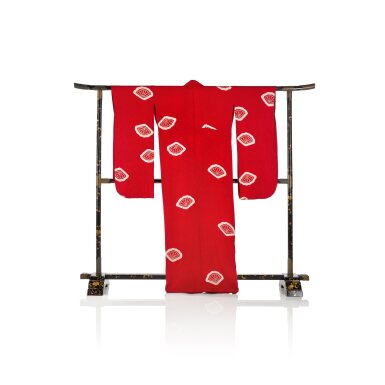Freddie Mercury's stage-worn costume, 1972-1974
featured on the cover of Queen's debut album, 1973
a bespoke two-piece asymmetrical suit of black and white satin, the v-neck top cut across a diagonal at the front into two panels, the right three-quarters in black with no sleeve, the left quarter white with one full length black sleeve with slit opening at inside seam from forearm to cuff, the back one complete white panel, with zip-fastening to right side; and a pair of flared satin trousers, the right leg black, the left white, with two-button fastening at waistband, the outside leg seams and waistband stitched in white thread, the interior waistband lined in ivory cotton with a red, grey and blue diagonal stripe, the flares 31 cm wide at foot, (both pieces unlabelled)
(qty 2)
Freddie wore this distinctive outfit on stage between 1972 and 1974, and Douglas Puddifoot’s shots of Queen performing at the Marquee Club on 22 December 1972 were used as the striking front cover image of Queen’s eponymous first album (1973). Freddie was also photographed by Mick Rock in this asymmetrical outfit at Queen’s landmark Imperial College shows on 26 October and 2 November 1973. Freddie also wore this suit on the BBC chart show Top Of The Pops performing 'Seven Seas Of Rhye' on 28 March 1974.
This stage outfit is one of the earliest stage-worn costumes in this collection. In an interview in 2000 Brian May spoke about how a photo of Freddie in this costume came to be the cover image for Queen's first album: “The artwork for our first album was coming on nicely – Freddie and I had been working on a collage of Doug’s [Puddifoot’s] designs pictures for the back cover [...] But the front cover was still a problem. One night I was flicking through the photos and I suddenly realized what a striking image Freddie in the spotlight made. I cut him out (cutting off his leg!), pasted him (slightly reduced) back on the spotlight image, and suddenly it jumped out as a cover. I remember thinking very consciously – Freddie as singer will be our figurehead – let’s use him as such.”
Mick Rock’s stage photographs, which are not specifically dated, of the two Imperial College shows on 26 October and 2 November 1973 show Freddie wearing this outfit on one of these occasions. In the book Killer Queen, Brian May recalls the November concert: "It is hard to describe how momentous this gig actually was for us. Imperial College was my own college… and over the previous couple of years I had continually scrounged time in lecture theatres to rehearse the band [lot 1130 is a jacket worn by Freddie in July 1970 at one of these rehearsals] [...] suddenly on this little stage, in the main hall for the first time ourselves we met an energy coming back towards us.”
Freddie also wore this asymmetrical outfit for studio photo shoots with Mick Rock, one of which features the band posing with a vast sceptre and crown, which was disliked by them all and kept under wraps for the next thirty years.
Black and white was key to Queen’s stage look for several during the early years of their career: "we have this black and white theme that we carry out in England and it’s very strong. It has even got to the point where the audience dress and look like me to a tee." (Freddie, quoted in Killer Queen). Freddie usually did his best to distance himself from any serious interpretation of the black and white themes in their work, telling a Mexican journalist in 1981, "It didn't have any special meaning". In another interview, he claimed simply that black and white were guitarist Brian May's favourite colours. But pushed by a European journalist in 1975, he did admit that the contrast reflected ‘the bisexuality thing’ and the differences between male and female genders.
LITERATUREFreddie Mercury: The Great Pretender, A Life In Pictures, 2012, illus. pp.44-45.Mick Rock & Queen, Killer Queen, The Official Limited Edition, Genesis Publications, 2003, illus. pp. 15-17, 20-21.Phil Sutcliffe, Queen, The Ultimate Illustrated History Of The Crown Kings Of Rock, Voyageur Press, 2009, illus. p.28
SPECIAL NOTICENo right to reproduce or commercially exploit the copyright or other intellectual propertyor image rights in any lot is included with the sale of the lot (including but not limited tosong lyrics, sketches, drawings and garment designs). Queen Productions Limited, QueenMusic Limited and other rights holders reserve all their rights. No right to exhibit in public or reproduce this lot is included with the sale of this lotwithout the prior written consent of Queen Productions Limited, who shall act in good faithto consider any such requests.
Freddie Mercury's stage-worn costume, 1972-1974
featured on the cover of Queen's debut album, 1973
a bespoke two-piece asymmetrical suit of black and white satin, the v-neck top cut across a diagonal at the front into two panels, the right three-quarters in black with no sleeve, the left quarter white with one full length black sleeve with slit opening at inside seam from forearm to cuff, the back one complete white panel, with zip-fastening to right side; and a pair of flared satin trousers, the right leg black, the left white, with two-button fastening at waistband, the outside leg seams and waistband stitched in white thread, the interior waistband lined in ivory cotton with a red, grey and blue diagonal stripe, the flares 31 cm wide at foot, (both pieces unlabelled)
(qty 2)
Freddie wore this distinctive outfit on stage between 1972 and 1974, and Douglas Puddifoot’s shots of Queen performing at the Marquee Club on 22 December 1972 were used as the striking front cover image of Queen’s eponymous first album (1973). Freddie was also photographed by Mick Rock in this asymmetrical outfit at Queen’s landmark Imperial College shows on 26 October and 2 November 1973. Freddie also wore this suit on the BBC chart show Top Of The Pops performing 'Seven Seas Of Rhye' on 28 March 1974.
This stage outfit is one of the earliest stage-worn costumes in this collection. In an interview in 2000 Brian May spoke about how a photo of Freddie in this costume came to be the cover image for Queen's first album: “The artwork for our first album was coming on nicely – Freddie and I had been working on a collage of Doug’s [Puddifoot’s] designs pictures for the back cover [...] But the front cover was still a problem. One night I was flicking through the photos and I suddenly realized what a striking image Freddie in the spotlight made. I cut him out (cutting off his leg!), pasted him (slightly reduced) back on the spotlight image, and suddenly it jumped out as a cover. I remember thinking very consciously – Freddie as singer will be our figurehead – let’s use him as such.”
Mick Rock’s stage photographs, which are not specifically dated, of the two Imperial College shows on 26 October and 2 November 1973 show Freddie wearing this outfit on one of these occasions. In the book Killer Queen, Brian May recalls the November concert: "It is hard to describe how momentous this gig actually was for us. Imperial College was my own college… and over the previous couple of years I had continually scrounged time in lecture theatres to rehearse the band [lot 1130 is a jacket worn by Freddie in July 1970 at one of these rehearsals] [...] suddenly on this little stage, in the main hall for the first time ourselves we met an energy coming back towards us.”
Freddie also wore this asymmetrical outfit for studio photo shoots with Mick Rock, one of which features the band posing with a vast sceptre and crown, which was disliked by them all and kept under wraps for the next thirty years.
Black and white was key to Queen’s stage look for several during the early years of their career: "we have this black and white theme that we carry out in England and it’s very strong. It has even got to the point where the audience dress and look like me to a tee." (Freddie, quoted in Killer Queen). Freddie usually did his best to distance himself from any serious interpretation of the black and white themes in their work, telling a Mexican journalist in 1981, "It didn't have any special meaning". In another interview, he claimed simply that black and white were guitarist Brian May's favourite colours. But pushed by a European journalist in 1975, he did admit that the contrast reflected ‘the bisexuality thing’ and the differences between male and female genders.
LITERATUREFreddie Mercury: The Great Pretender, A Life In Pictures, 2012, illus. pp.44-45.Mick Rock & Queen, Killer Queen, The Official Limited Edition, Genesis Publications, 2003, illus. pp. 15-17, 20-21.Phil Sutcliffe, Queen, The Ultimate Illustrated History Of The Crown Kings Of Rock, Voyageur Press, 2009, illus. p.28
SPECIAL NOTICENo right to reproduce or commercially exploit the copyright or other intellectual propertyor image rights in any lot is included with the sale of the lot (including but not limited tosong lyrics, sketches, drawings and garment designs). Queen Productions Limited, QueenMusic Limited and other rights holders reserve all their rights. No right to exhibit in public or reproduce this lot is included with the sale of this lotwithout the prior written consent of Queen Productions Limited, who shall act in good faithto consider any such requests.















Testen Sie LotSearch und seine Premium-Features 7 Tage - ohne Kosten!
Lassen Sie sich automatisch über neue Objekte in kommenden Auktionen benachrichtigen.
Suchauftrag anlegen